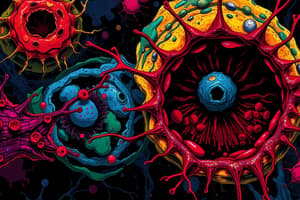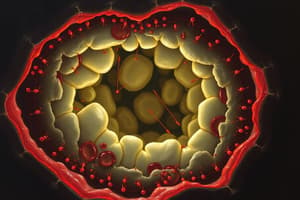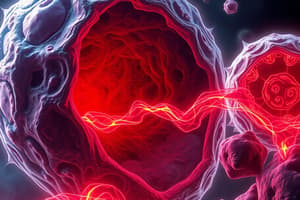Podcast
Questions and Answers
What defines apoptosis in the context of cell death?
What defines apoptosis in the context of cell death?
- A process involving acute inflammation
- An irreversible process due to injury
- Enzymatic digestion of cellular structures
- An internally programmed series of events leading to cell elimination (correct)
Which type of necrosis is most commonly associated with ischemia?
Which type of necrosis is most commonly associated with ischemia?
- Liquefactive necrosis
- Fibrinoid necrosis
- Coagulative necrosis (correct)
- Caseous necrosis
What is a characteristic morphological feature of necrotic cells?
What is a characteristic morphological feature of necrotic cells?
- Fragmented nuclear structure (correct)
- Uniform cell membranes
- Retention of nuclear details
- Increased cell membrane integrity
What does the term 'karyolysis' refer to in necrotic cells?
What does the term 'karyolysis' refer to in necrotic cells?
During coagulative necrosis, what happens to normal cells?
During coagulative necrosis, what happens to normal cells?
Which condition is most likely to result in necrosis due to hypoxia?
Which condition is most likely to result in necrosis due to hypoxia?
What is the primary cause of necrosis as described?
What is the primary cause of necrosis as described?
Which of the following will NOT typically occur in necrotic tissue?
Which of the following will NOT typically occur in necrotic tissue?
What is the primary cause of fat necrosis?
What is the primary cause of fat necrosis?
What do the chalky, white areas in fat necrosis result from?
What do the chalky, white areas in fat necrosis result from?
Which necrosis type is typically associated with immune reactions in blood vessels?
Which necrosis type is typically associated with immune reactions in blood vessels?
Which of the following statements about apoptosis is true?
Which of the following statements about apoptosis is true?
What is the gross appearance of fibrinoid necrosis?
What is the gross appearance of fibrinoid necrosis?
Which condition can be an example of pathological apoptosis?
Which condition can be an example of pathological apoptosis?
Which example illustrates physiological apoptosis?
Which example illustrates physiological apoptosis?
What feature is NOT characteristic of apoptosis?
What feature is NOT characteristic of apoptosis?
What is the primary characteristic of coagulative necrosis as observed in kidney infarction?
What is the primary characteristic of coagulative necrosis as observed in kidney infarction?
In which type of necrosis is the necrotic material often creamy yellow and referred to as pus?
In which type of necrosis is the necrotic material often creamy yellow and referred to as pus?
What type of necrosis is described as having a 'cottage cheese-like' appearance?
What type of necrosis is described as having a 'cottage cheese-like' appearance?
Which inflammatory cells are primarily associated with liquefactive necrosis?
Which inflammatory cells are primarily associated with liquefactive necrosis?
What is the process through which necrotic cells are removed during necrosis?
What is the process through which necrotic cells are removed during necrosis?
Which condition is commonly associated with liquefactive necrosis?
Which condition is commonly associated with liquefactive necrosis?
What histological feature is observed in caseous necrosis?
What histological feature is observed in caseous necrosis?
Which of the following best describes the infiltration of inflammatory cells during necrosis?
Which of the following best describes the infiltration of inflammatory cells during necrosis?
What triggers apoptosis when there is an accumulation of misfolded proteins?
What triggers apoptosis when there is an accumulation of misfolded proteins?
Which enzyme is considered an important final executor in the process of apoptosis?
Which enzyme is considered an important final executor in the process of apoptosis?
What distinguishes necrosis from apoptosis in terms of cell membrane integrity?
What distinguishes necrosis from apoptosis in terms of cell membrane integrity?
During apoptosis, which morphological feature is typically observed?
During apoptosis, which morphological feature is typically observed?
Which statement accurately reflects the fate of cells undergoing apoptosis?
Which statement accurately reflects the fate of cells undergoing apoptosis?
Which of the following best describes the circumstances under which apoptosis occurs?
Which of the following best describes the circumstances under which apoptosis occurs?
What morphological change occurs to cells undergoing apoptosis?
What morphological change occurs to cells undergoing apoptosis?
What defines the biochemical mechanism of apoptosis compared to necrosis?
What defines the biochemical mechanism of apoptosis compared to necrosis?
Study Notes
Cell Death: Necrosis and Apoptosis
-
Necrosis: Cell death due to enzymatic digestion of cellular components, causing changes in cell structure.
- Causes: Hypoxia, free radicals, cell membrane damage, increased intracellular calcium.
- Characteristics:
- Involves a group of cells.
- Cells become eosinophilic (pink) and glassy.
- Cell membranes fragment.
- Nuclear changes:
- Pyknosis: Nuclear shrinkage.
- Karyorrhexis: Nuclear fragmentation.
- Karyolysis: Nuclear dissolution.
- Presence of inflammatory cells.
- Types:
- Coagulative Necrosis: Most common, occurs due to ischemia (loss of blood flow).
- Grossly: Tissue is firm, often wedge-shaped and pale.
- Microscopically: Cells retain their outlines, with loss of cytoplasmic and nuclear details.
- Examples: Kidney infraction, myocardial infarction, splenic infarct.
- Liquefactive Necrosis: Caused by enzymatic lysis of cells, transforming tissue into a viscous liquid.
- Causes: Bacterial or fungal infections, brain infarction.
- Grossly: Tissue is liquidy and creamy yellow (pus).
- Microscopically: Abundance of neutrophils and cell debris.
- Examples: Cerebral Infarction.
- Caseous Necrosis: Necrotic tissue with a "cottage cheese-like" appearance.
- Grossly: Soft and friable.
- Microscopically: Loss of cell outlines, acellular pink areas of necrosis surrounded by a granulomatous inflammatory process.
- Examples: Tuberculosis lesions, fungal infections.
- Fat Necrosis: Necrosis in adipose tissue induced by lipases.
- Causes: Trauma, pancreatitis.
- Grossly: Chalky white areas (saponification).
- Microscopically: Shadowy outlines of dead fat cells surrounded by calcium deposits and inflammation.
- Fibrinoid Necrosis: Form of necrosis seen in immune reactions involving blood vessels, where immune complexes and fibrin are deposited in the vessel walls.
- Grossly: Changes too small to be seen.
- Microscopically: Vessel walls are thickened and pinkish-red.
- Examples: Malignant hypertension, vasculitis (polyarteritis nodosa).
- Coagulative Necrosis: Most common, occurs due to ischemia (loss of blood flow).
-
Apoptosis: Programmed cell death, involves the elimination of unwanted cells without eliciting inflammation.
- Mechanism:
- Involves single cells or small groups of cells.
- Requires cellular signals that activate protein cleavage, leading to cellular death.
- Energy-dependent process.
- Characteristics:
- Cell shrinkage.
- Membrane blebbing.
- Chromatin condensation.
- Nuclear fragmentation.
- Formation of apoptotic bodies.
- Phagocytosis of apoptotic bodies by macrophages.
- Types:
- Physiological Apoptosis: A normal process to eliminate cells that are no longer needed, maintaining homeostasis.
- Examples: Removal of excess cells during development, involution of hormone-dependent tissues, endometrial cell breakdown during menstruation, regression of lactating breast.
- Pathological Apoptosis: Eliminates injured cells without eliciting tissue damage.
- Examples: DNA damage from radiation or chemotherapy, accumulation of misfolded proteins, infections (particularly viral), atrophy in parenchymal organs following duct obstruction (pancreas, parotid gland, kidney).
- Physiological Apoptosis: A normal process to eliminate cells that are no longer needed, maintaining homeostasis.
- Mechanism:
-
Apoptotic Pathway:
- Pro-apoptotic: Cytochrome c.
- Anti-apoptotic: Bcl-2.
- Activation of Caspases: Caspases activate proteases and endonucleases that break down the DNA.
- Caspase-3 is a key final enzyme in this process.
Differences between Necrosis and Apoptosis
- Induction: Necrosis is primarily pathological, while apoptosis can be both physiological and pathological.
- Number of Cells: Necrosis involves groups of cells, while apoptosis affects single cells or small clusters.
- Cell Membrane: Necrosis leads to loss of membrane integrity, while apoptosis maintains membrane integrity.
- Cell Size: Necrosis causes cell swelling, while apoptosis results in cell shrinkage and fragmentation.
- Nucleus: Necrosis features nuclear changes like pyknosis, karyorrhexis, and karyolysis. Apoptosis involves nuclear condensation and fragmentation into apoptotic bodies.
- Inflammation: Necrosis triggers an inflammatory response, while apoptosis does not cause inflammation.
- Fate of cells: In necrosis, cells are phagocytosed by neutrophils and macrophages, while in apoptosis, they are phagocytosed by neighboring cells.
- Biochemical Mechanism: Necrosis is energy-independent, while apoptosis is energy-dependent and involves protease and endonuclease activity.
Studying That Suits You
Use AI to generate personalized quizzes and flashcards to suit your learning preferences.
Related Documents
Description
Explore the mechanisms and characteristics of cell death, focusing on necrosis and apoptosis. Understand the causes, types, and changes that occur during these processes, including the distinct features of coagulative necrosis. This quiz will test your knowledge of essential concepts in cellular biology related to cell death.




